by Robert Kelley
On August 6, Jeb Bush did us the tremendous favor of reminding us of the bad intelligence that led us into a strategic disaster in Iraq that has resulted in the deaths of hundreds of thousands—nearly 5,000 of them American. Actually, it wasn’t bad intelligence. It was cherry-picked intelligence, even faked, and designed to mislead politicians and the public into believing, among other things, that Iraq was actively developing a nuclear weapon.
Politicized intelligence may be at work once again. On August 5, a Bloomberg column (“Iran Already Sanitizing Nuclear Site, Intel Warns”) by Josh Rogin and Eli Lake reported that the “U.S. intelligence community” had informed Congress of “evidence that Iran was sanitizing its suspected military site at Parchin, in broad daylight, days after agreeing to a nuclear deal with world powers.” The column cited an August 3 briefing to the Senate Intelligence Committee by the Office of the Director of National Intelligence (ODNI) that disclosed “satellite imagery picked up by U.S. government assets in mid- and late July show[ing] that Iran had moved bulldozers and heavy machinery to the Parchin site.” The ODNI had reportedly concluded “with high confidence that the Iranian government was working to clean up the site ahead of planned inspections by the IAEA (International Atomic Energy Agency).”
“I am familiar with it,’ Committee Chairman Richard Burr told Rogin and Lake on Tuesday. “I think it’s up to the administration to draw their conclusions. Hopefully this is something they will speak on, since it is in many ways verified by commercial imagery. And their actions seem to be against the grain of the agreement.”
Responding to these revelations with unusual clarity and speed, the Iranian mission at the UN immediately rejected the charges, calling them “preposterous.”
The Parchin military complex covers a very vast area, which includes different military, industrial, administrative and residential sections. It is, thus quite normal to have construction works underway at any time.
Let’s Go to the Photos
Enter David Albright, president of the Institute for Science and International Security (ISIS), who (inadvertently) exposed the questionable basis for the Bloomberg column. ISIS published three commercially available satellite images of a “parking lot” located close to a building that Albright has long claimed was the site of proscribed nuclear-weapons-related experiments before 2003. Two of the three images—captured during July 12, 19, and 26, respectively—were captured after the signing of the Joint Comprehensive Program of Action signed in Geneva July 14 and presumably covered the period referred to in the ODNI’s briefing. And, like the U.S. government satellite imagery, all three of the photos that ISIS released were taken “in broad daylight.”
So what did the latter photos reveal? In the first two images, nothing is happening: no vehicles, no earthmovers, no activities of any strategic significance. In the third image, two vehicles are seen parked near a gate to the compound. Each vehicle is about four meters long and resembles the sedan automobiles, one black and one white, that are commonly seen in satellite photos throughout Parchin (a hilly area of more than 50 square kilometers). In fact, three passenger sedans are seen occupying almost exactly the same spots near the gate in a Google Earth photograph taken on May 11, 2015—some five weeks before the JCPOA was concluded.
Moreover, a survey of other publicly available satellite images of the suspect site shows that, with just a few exceptions, several cars were parked at this very same parking lot every workday of the week (except Fridays, the Islamic sabbath). According to these images, the number of vehicles parked at the site actually decreased in late July. The sedans depicted in the July 26 ISIS photo are too small to be capable of moving earth (despite ISIS’s description of the black one as “possibly” a bulldozer or steamroller), and nothing else is going on anywhere else in the scene. In short, there is no evidence whatsoever of efforts to “sanitize” the area in or around the suspect site.
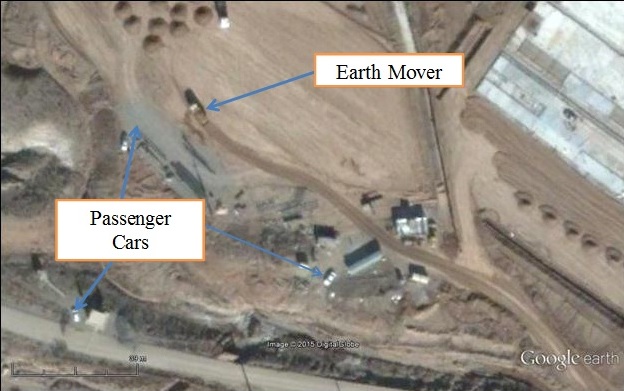
The reader can compare the relative sizes of an earthmover (about 8 meters long) and a typical Parchin sedan (about 4 meters long) in this January 2015 satellite image taken in a completely different part of the Parchin site. Thus, the object ISIS labeled an “unidentified vehicle, possibly bulldozer or steamroller” in its July 26 photo appears far too small to have been an earthmover of the kind used in at Parchin.
ISIS subsequently released a much broader view of the July 26 image that depicted a larger area in Parchin, including the site that is supposed to have been subject to “sanitization.” But that image also offers no evidence of earthmoving or anything else that could be considered part of an effort to “sanitize” the site. It did depict another parking lot housing 20 vehicles. But 20 vehicles on average have been parked on workdays at the very same lot over the past five years, according to a survey of 36 publicly available satellite images captured since 2010.
The question Albright himself posed in an op-ed published in the August 11 print edition of The Washington Post is indeed the correct one. Quoting Chico Marx, he asked “Who you gonna believe? Me or your own eyes?” In this case, we have to rely on the eyes Albright himself has provided us through the commercial satellite images he published on the ISIS website. And what they show belies the ODNI’s testimony as reported by Chairman Burr and the other various unnamed sources cited by Bloomberg’s Rogin and Lake. There were no “sanitization” activities taking place “in broad daylight” after the JCPOA was signed July 14. Albright deserves our thanks for clarifying this issue.
Elsewhere in Parchin
We cannot exclude the possibility that the ODNI was referring to “sanitization” activity in an entirely different area within the Parchin complex, an area that neither the IAEA nor the U.S. intelligence community has ever publicly designated. Until now, the assumption has been that the site subject to “sanitization” is the same as that on which ISIS has focused its attention. According to the group, the building depicted in the photographs houses a large explosive containment chamber in which Iran may have experimented with simulated internal components of a nuclear weapon using natural uranium before 2003.
Since November 2011, when the IAEA published a report regarding such tests based on intelligence submitted by an unnamed member state (paragraph 49 of the Annex), the IAEA has claimed on several occasions that Iran has tried to “sanitize” the site through bulldozing, road-building, culvert-digging, and other activities. Last December I wrote a piece for LobeLog addressing the probability—or, rather, improbability—that such a containment chamber (as well as the tests it was allegedly designed to contain) ever existed at the particular site identified by ISIS.
The Iraq war and the disasters that followed it were largely based upon politicized intelligence and selective leaks. That pattern may be repeating here. Chairman Burr did not say that he agreed with the intelligence, only that he was familiar with it. In light of the enormous stakes in the pending Iran deal, responsible lawmakers should demand a hearing on who leaked the latest intelligence to the press and what were their motivations for doing so. They should also demand a comprehensive assessment of the entire Parchin controversy and the repeated claims regarding efforts to “sanitize” whatever purported nuclear-weapons-related activity took place there.
Despite the clear evidence revealed by ISIS’s most recent photos that nothing significant has been going on at the suspect site since the JCPOA was signed, IAEA Director General Yukiya Amano was peppered with questions about Parchin in his testimony before the Senate Foreign Relations Committee last week. Bad intelligence may be coming around again. And a lot more people may die this time.
[Editor’s Note: Kelley is a veteran of over 35 years in the US Department of Energy’s nuclear weapons complex, most recently at Los Alamos. He managed the centrifuge and plutonium metallurgy programs at Lawrence Livermore National Laboratory and was later Director of the Department of Energy Remote Sensing Laboratory, the premier US nuclear emergency response organization. He was also seconded by the USDOE to the IAEA where he served twice as a Director of the nuclear inspections in Iraq, in 1992 and 2001. For those of LobeLog’s readers who were interested in his critique of the IAEA’s analysis of the al-Kibar site in Syria, he has just published a new study for the Stockholm Peace Research Institute (SIPRI), of which he is an associate research fellow. It can be found here.]


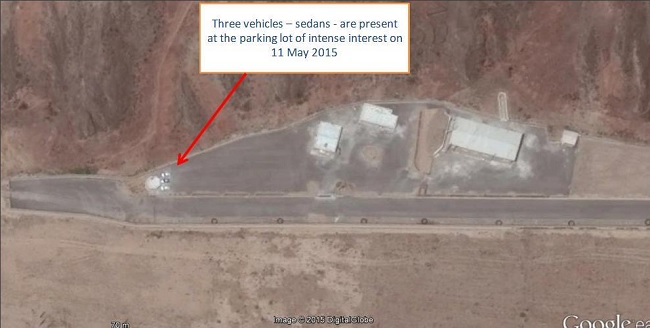
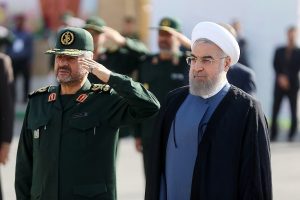
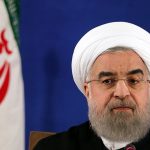

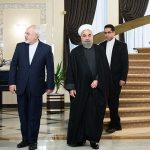
Regarding bad intelligence, the Iraqi informer, called Curveball, was known to be a fake, but his fake information about mobile WMD facilities were used anyway by Colin Powell to justify the Iraq invasion anyway. A year or two ago, 60 Minutes had Curveball on their show and he admitted he was lying. Any investigation going on about the people who purposefully used toe fake information to justify the Iraq invasion? Uh, no. But many of them are now advisors to Jeb Bush.
Not a word in the news on the 409 missiles in Poland, 239 missiles in Romania and on 32 ships in the Mediterranean to defend us from Iran or maybe N.Korea. Of course, the Russians don’t believe that fairy tale. European Phased Adaptive Approach=Suicide by stupid, crazy, bloody fools in Pentagon/Washington. Best info: Google Scott Horton interviews Ray McGovern: The New Cold War With Russia, and comments.
Iraq was not bad intelligence. The Downing Street memos prove it was a deliberate deception
‘Bad intelligence’? What does that mean? They got it wrong? . It was never ‘bad intelligence’, it was falsified intelligence, made up, a premeditated crime. Disappointing to see this kind of neo-con crap making it into this kind of publication.
David, please read the first two paragraphs. That is exactly what it says. Politicized. Cherry picked. Group think.